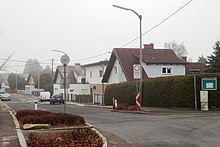Schörgenhub suburban housing estate
The suburban housing estate Schörgenhub (also Hütterland ) was built between 1933 and 1937 and with originally 180 houses is the largest suburban settlement in Linz . It is located in the Kleinmünchen district and is essentially bounded by the Dauphinestrasse , Salzburger Strasse and Am Langen Zaun streets .
history
The name Schörgenhub is derived from a rural field name, the area used to be arable land.
In the course of the marginal settlement campaign of the Christian Social Federal Government of Dollfuß , single-family and semi-detached houses were built for the unemployed and working-class families looking for accommodation with relatively large plots of land so that they could largely provide for themselves with this property ( see suburban settlement ).
The outskirts of Schörgenhub - not to be confused with the Schörgenhubsiedlung (aka Hitlerbauten Neue Heimat ) built during the Nazi era - was built by the family building cooperative according to plans by the architect Hans Arndt and mainly comprises semi-detached houses of the same construction in traditional architecture. Apart from a small, square-like widening of the street with a lane divider in the street Im Bäckerwinkel, the settlement has no actual center.
In the time of National Socialism, the Reichsautobahn (today A1 West Autobahn ) and thus the construction of the Linz feeder , which was completed after the Second World War, began. This was a dead straight two-lane road in the course of today's A7 Mühlkreis Autobahn from the Linz junction of the Westautobahn to Salzburger Strasse near Seimayr in an extension of Hanuschstrasse, which divided the settlement into two parts. As a result, some settlement houses were demolished and the residents were relocated. In the mid-1960s, the two-lane road was expanded into a four-lane motorway (A7) and more houses were demolished. While it was still possible to cross the old Linz feeder in several places without any problems, all cross roads were interrupted by the conversion to a motorway. A bridge was only built for Dauphinestrasse.
The settlement today
Due to the relatively generous land and the proximity to the water forest , the settlement is today a popular residential area in Kleinmünchen, a district in which workers' apartment blocks from the war and post-war period dominate. Personalities such as the graphic artist and painter Alfred Würl also lived in this settlement.
The still existing settlement houses and ensembles are now acutely threatened by densification, demolition and renovation, as the buildings are not listed . On the part of politics and monument preservation, there was little interest in preserving the suburban settlements from the time of the corporate state - in contrast to workers' settlements that were built under Social Democratic or National Socialist leadership (e.g. the listed settlements Sintstraße and Scharlinz / Haydnstraße or . Harbach and Gründbergsiedlung).
literature
- Julius School and its students. Linz 1933 ( digital )
- Cornelia Hochmayr, Ingo Mörth: Linz's cultural districts today. Kleinmünchen. Linz 2009 ( digital )
Web links
Individual evidence
- ↑ Julius School and its students. Linz 1933, p. 75
Coordinates: 48 ° 15 ′ 16.7 ″ N , 14 ° 17 ′ 35 ″ E


